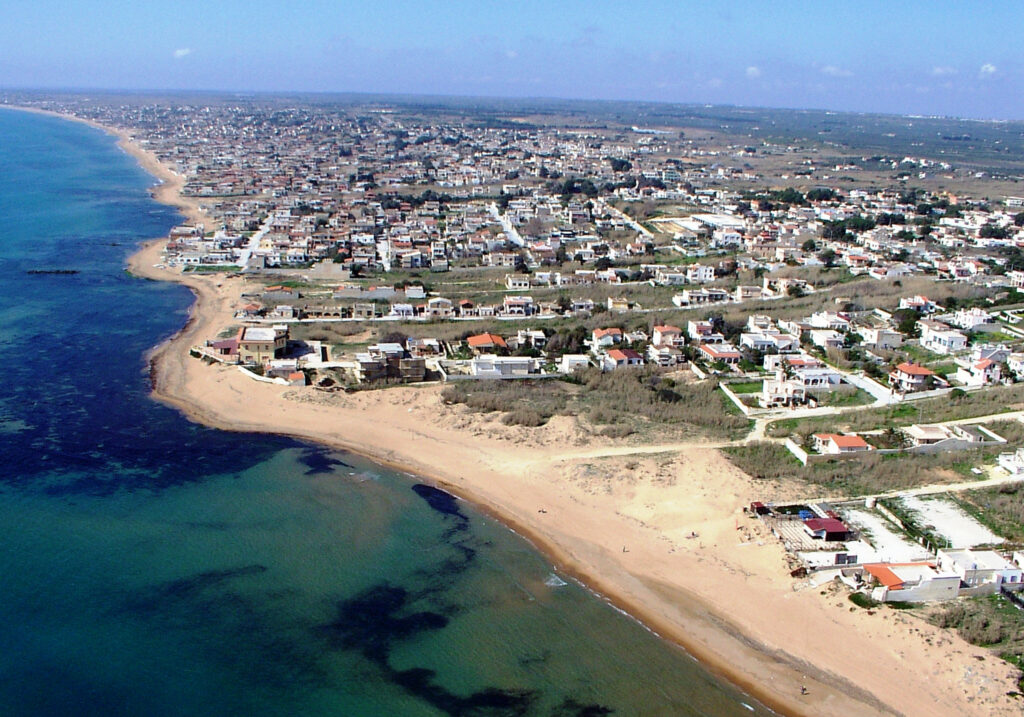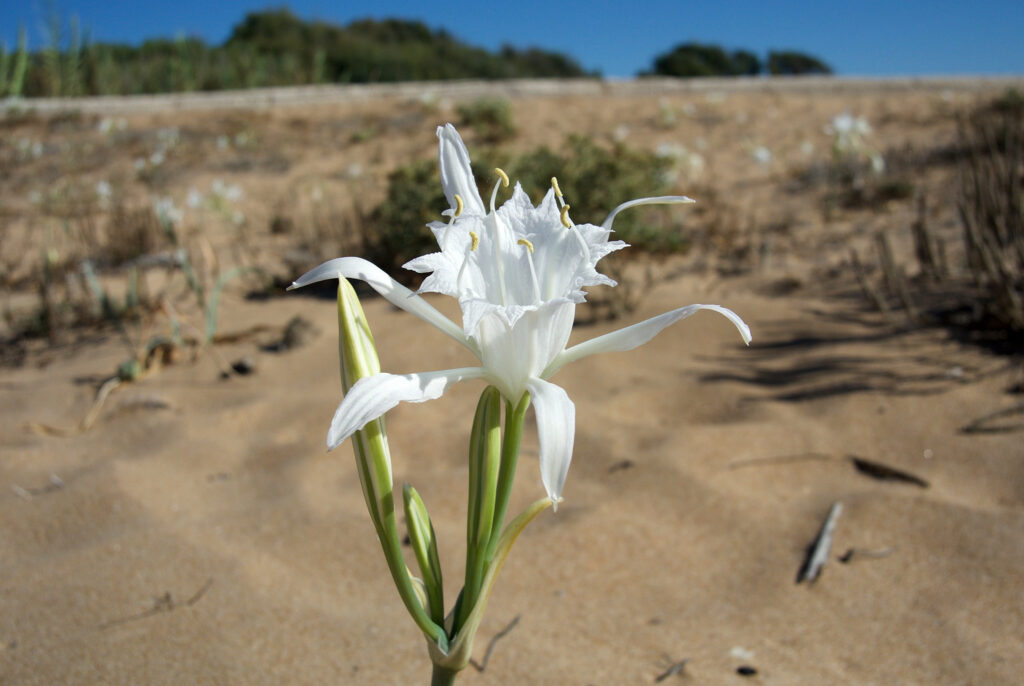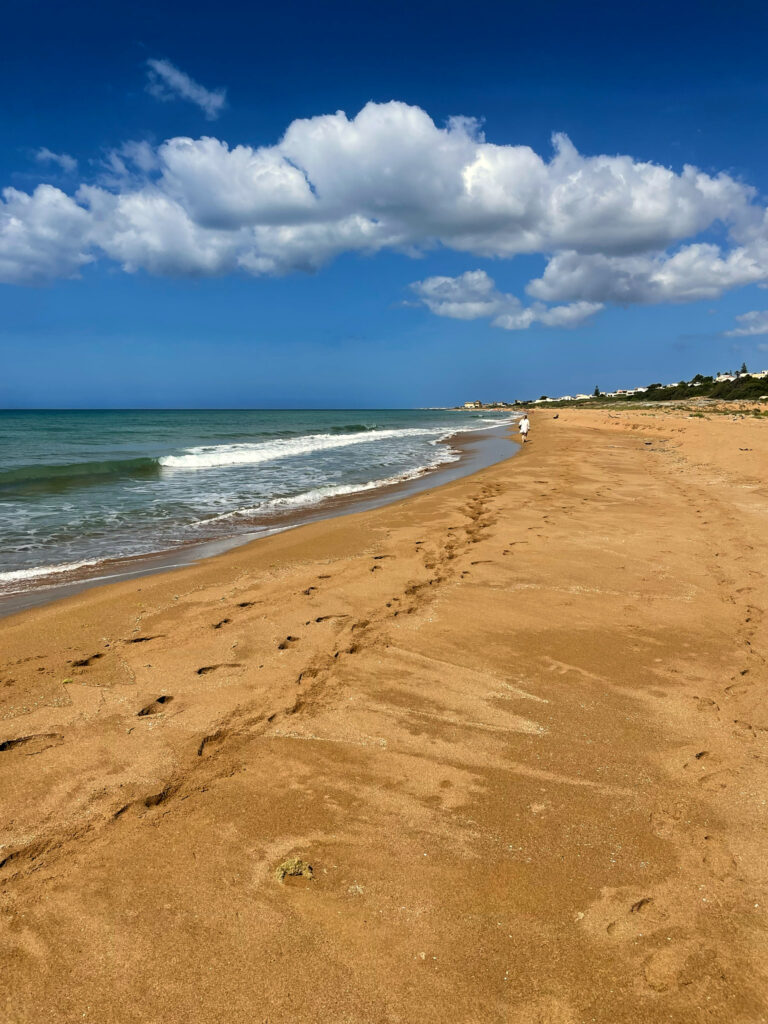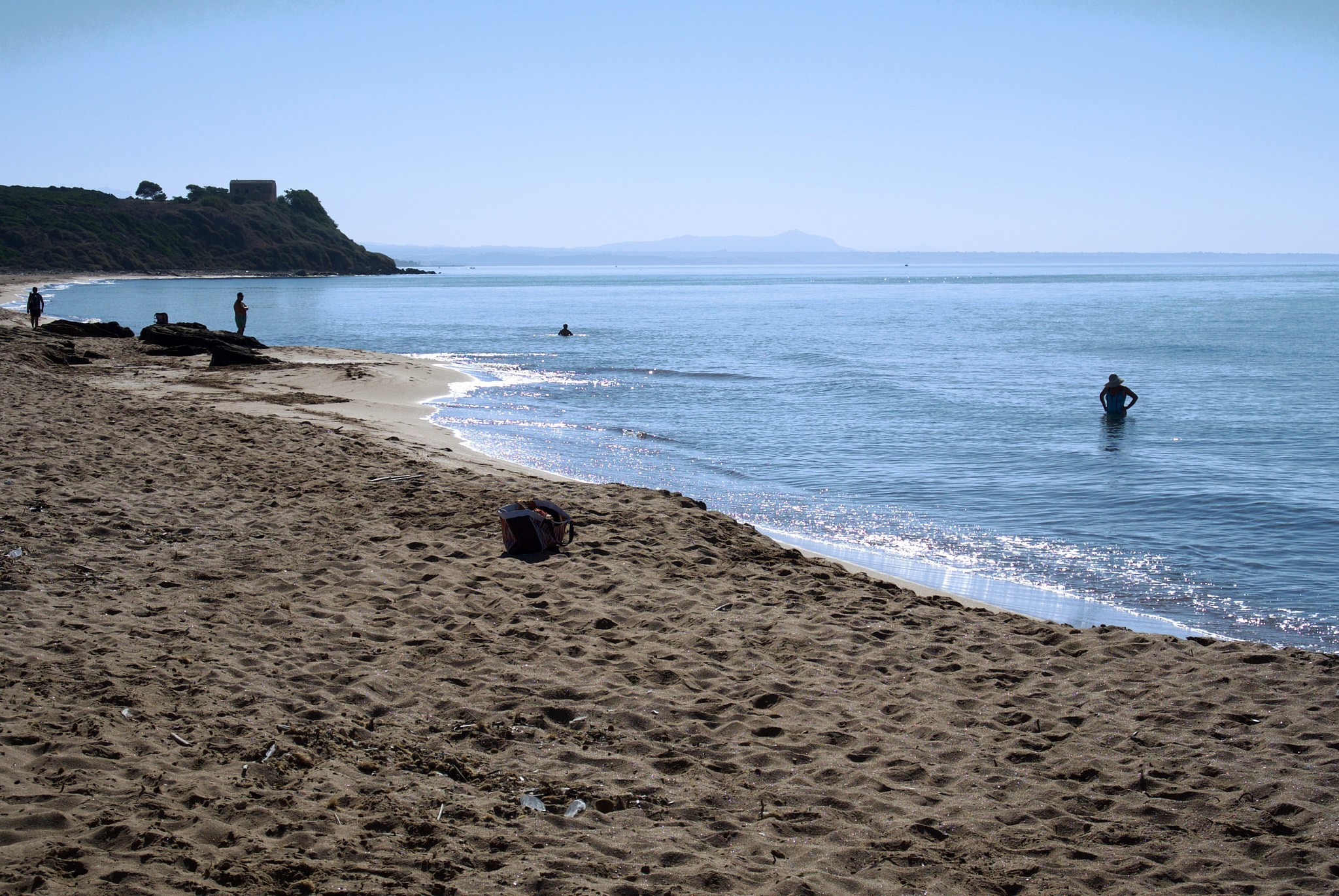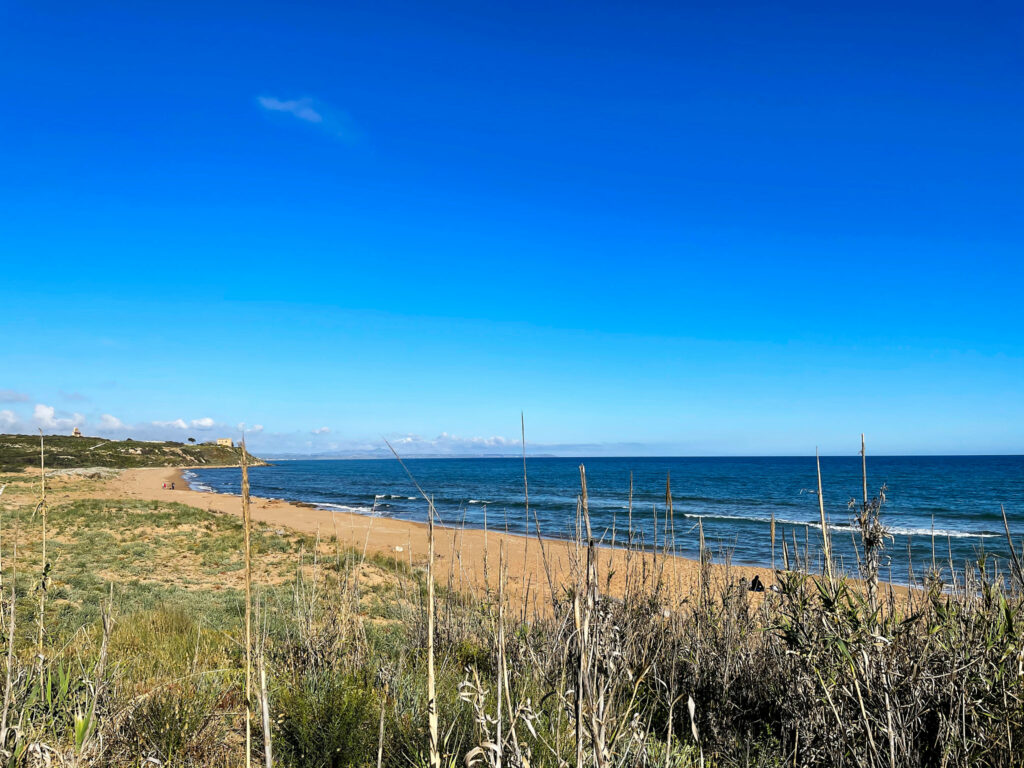
La località di Triscina, posta sul litorale siciliano in corrispondenza del territorio del comune di Castelvetrano, prende il suo nome da una particolare alga rossa di cui era molto ricco il suo mare. I fenomeni atmosferici agendo sulla sabbia hanno creato nel tempo un peculiare sistema a dune. La natura dei luoghi tiene lontano l’uomo durante la preistoria e la protostoria. Solo all’inizio del “bronzo antico” (2000 – 1800 a.c.) si rileva il primo fenomeno di antropizzazione dell’areale. Infatti, in questo periodo una comunità indigena si stanzia sul piccolo corrugamento del “Timpone nero”. Le prove inconfutabili di tali preesistenze si hanno negli anni ’60, quando un gruppo intercetta e distrugge delle ricchissime tombe a grotticella artificiale. Lo studio sul materiale viene condotto dalla Dott.ssa Marconi Bovio, che riesce a datare l’intero complesso. In seguito il processo di antropizzazione sembra arrestarsi; poche, infatti, sono le testimonianze di presenza umana fino al VII° secolo a.C., dunque, fino alla nascita di Selinunte. Attorno al 650 a.C. i coloni di Megara Iblea, guidati dall’ecista Pammilo, fondano su una serie di colline poste sulla sinistra del Modione (antico Selino) la dorica Selinunte: I Selinuntini realizzano sul lato destro del Modione (praticamente all’inizio della località di Triscina) una serie di santuari, ora noti come santuario della Malphoros, nello stesso sito, come sostengono alcuni studiosi, dove esisteva un santuario pansicano dedicato a divinità ctonie. Tali costruzioni sono le uniche che i Selinuntini edificano a Triscina. Tuttavia, scelgono la località per istallare, a partire del VI° secolo a.C., la loro più estesa necropoli. Distrutta Selinunte e cessati i cortei funebri, non si hanno più notizie di frequenza umana nei luoghi di Triscina. Sicuramente la presenza della necropoli contribuisce, nel Medioevo, alla nascita di superstizioni. A cominciare dal XVI° secolo la paura di incursioni barbaresche spopola ancora di più questi territori. Per contrastare le razzie verso la fine del XVI° secolo il viceré di Sicilia dà all’Ingegnere Camillo Camilliani l’incarico di progettare un sistema costiero di torri di avvistamento. Tre di queste vengono realizzate nel territorio di Castelvetrano.

The locality of Triscina, located on the Sicilian coastline in the territory of the municipality of Castelvetrano, takes its name from a particular red seaweed in which its sea was very rich. Atmospheric phenomena acting on the sand have created a peculiar dune system over time. The nature of the area kept man away during prehistoric and protohistoric times. It was not until the beginning of the ‘Old Bronze’ (2000 – 1800 B.C.) that the first phenomenon of anthropisation of the area was observed. In fact, in this period an indigenous community settled on the small corrugation of the ‘Black Timpone’. The irrefutable evidence of such pre-existences occurs in the 1960s, when a group intercepts and destroys some very rich artificial cave tombs. The study of the material was conducted by Dr. Marconi Bovio, who succeeded in dating the entire complex. Thereafter, the process of anthropisation seems to come to a halt; in fact, there is little evidence of human presence until the 7th century B.C., thus, until the birth of Selinunte. Around 650 BC, colonists from Megara Iblea, led by the ecist Pammilo, founded the Doric Selinunte on a series of hills to the left of the Modione (ancient Selino): The Selinuntines built on the right side of the Modione (practically at the beginning of the locality of Triscina) a series of sanctuaries, now known as the sanctuary of the Malphoros, on the same site, as some scholars claim, where there was a Pan-Hellenic sanctuary dedicated to chthonic deities. These constructions are the only ones the Selinuntines built in Triscina. However, they chose the locality to install their largest necropolis from the 6th century B.C. onwards. Once Selinunte was destroyed and funeral processions ceased, there are no more reports of human habitation in the Triscina area. Certainly the presence of the necropolis contributed to the emergence of superstitions in the Middle Ages. Beginning in the 16th century, fear of barbarian raids depopulated these territories even more. To counter the raids towards the end of the 16th century, the viceroy of Sicily commissioned the engineer Camillo Camilliani to design a coastal system of watchtowers. Three of these were built in the territory of Castelvetrano.

La localité de Triscina, située sur le littoral sicilien, sur le territoire de la commune de Castelvetrano, tire son nom d’une algue rouge particulière dont la mer était très riche. Les phénomènes atmosphériques agissant sur le sable ont créé au fil du temps un système dunaire particulier. La nature de la zone a tenu l’homme à l’écart pendant la préhistoire et la protohistoire. Ce n’est qu’au début du “Bronze ancien” (2000 – 1800 av. J.-C.) que l’on a observé le premier phénomène d’anthropisation de la région. En effet, c’est à cette époque qu’une communauté indigène s’est installée sur la petite ondulation de la “Timpone noire”. La preuve irréfutable de cette préexistence apparaît dans les années 1960, lorsqu’un groupe intercepte et détruit des tombes rupestres artificielles très riches. L’étude du matériel a été menée par le Dr Marconi Bovio, qui a réussi à dater l’ensemble du complexe. Par la suite, le processus d’anthropisation semble s’arrêter ; il y a peu de traces de présence humaine jusqu’au VIIe siècle avant J.-C., donc jusqu’à la naissance de Sélinonte. Vers 650 av. J.-C., des colons de Megara Iblea, conduits par l’éciste Pammilo, fondèrent la Sélinonte dorique sur une série de collines situées sur la rive gauche du Modion (l’ancien Selino) : Les Sélinontins construisirent sur la rive droite du Modion (pratiquement au début de la localité de Triscina) une série de sanctuaires, aujourd’hui connus sous le nom de sanctuaire de Malphoros, à l’endroit même, comme le prétendent certains spécialistes, où se trouvait un sanctuaire panhellénique dédié aux divinités chthoniennes. Ces constructions sont les seules que les Sélinontins ont édifiées à Triscina. Cependant, ils ont choisi cette localité pour y installer leur plus grande nécropole à partir du VIe siècle av. Après la destruction de Sélinonte et l’arrêt des processions funéraires, il n’y a plus de traces d’habitations humaines dans la région de Triscina. La présence de la nécropole a certainement contribué à l’émergence de superstitions au Moyen Âge. À partir du XVIe siècle, la crainte des raids barbares dépeuple encore plus ces territoires. Pour contrer les raids vers la fin du XVIe siècle, le vice-roi de Sicile chargea l’ingénieur Camillo Camilliani de concevoir un système côtier de tours de guet. Trois d’entre elles ont été construites sur le territoire de Castelvetrano.

Der Ort Triscina liegt an der sizilianischen Küste auf dem Gebiet der Gemeinde Castelvetrano und hat seinen Namen von einer besonderen roten Alge, an der das Meer sehr reich war. Atmosphärische Phänomene, die auf den Sand einwirken, haben im Laufe der Zeit ein eigentümliches Dünensystem geschaffen. Die Beschaffenheit des Gebiets hat den Menschen in der Ur- und Frühgeschichte ferngehalten. Erst zu Beginn der “Alten Bronze” (2000 – 1800 v. Chr.) wurde das erste Phänomen der Anthropisierung des Gebiets beobachtet. In dieser Zeit siedelte sich nämlich eine indigene Gemeinschaft auf der kleinen Riffelung des “Schwarzen Timpone” an. Der unwiderlegbare Beweis für eine solche Präexistenz wird in den 1960er Jahren erbracht, als eine Gruppe einige sehr reiche künstliche Höhlengräber abfängt und zerstört. Die Untersuchung des Materials wurde von Dr. Marconi Bovio durchgeführt, dem es gelang, den gesamten Komplex zu datieren. Danach scheint der Prozess der Anthropisierung zum Stillstand zu kommen; bis zum 7. Jahrhundert v. Chr., also bis zur Geburt von Selinunte, gibt es nur wenige Hinweise auf menschliche Anwesenheit. Um 650 v. Chr. gründeten Kolonisten aus Megara Iblea unter der Führung des Ökisten Pammilo das dorische Selinunte auf einer Reihe von Hügeln auf der linken Seite des Modion (dem antiken Selino): Die Selinuntiner errichteten auf der rechten Seite des Modion (praktisch am Anfang der Ortschaft Triscina) eine Reihe von Heiligtümern, die heute als Heiligtum des Malphoros bekannt sind, und zwar an der gleichen Stelle, an der sich nach Ansicht einiger Gelehrter ein panhellenisches Heiligtum befand, das chthonischen Gottheiten gewidmet war. Diese Bauten sind die einzigen, die die Selinuntiner in Triscina errichteten. Allerdings wählten sie den Ort, um dort ab dem 6. Jahrhundert v. Chr. ihre größte Nekropole zu errichten. Nach der Zerstörung von Selinunte und dem Ende der Begräbniszeremonien gibt es keine Berichte mehr über menschliche Besiedlung in der Gegend von Triscina. Sicherlich trug die Nekropole zum Aufkommen des Aberglaubens im Mittelalter bei. Ab dem 16. Jahrhundert entvölkerte die Angst vor Barbarenüberfällen diese Gebiete noch mehr. Um den Überfällen gegen Ende des 16. Jahrhunderts zu begegnen, beauftragte der Vizekönig von Sizilien den Ingenieur Camillo Camilliani mit der Planung eines Systems von Wachtürmen an der Küste. Drei davon wurden auf dem Gebiet von Castelvetrano errichtet.
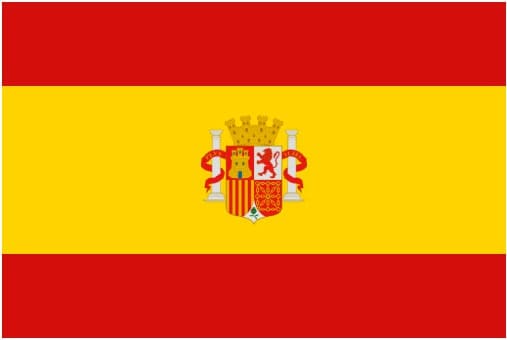
La localidad de Triscina, situada en el litoral siciliano, en el territorio del municipio de Castelvetrano, toma su nombre de una particular alga roja en la que era muy rico su mar. Los fenómenos atmosféricos que actúan sobre la arena han creado con el tiempo un peculiar sistema dunar. La naturaleza de la zona mantuvo alejado al hombre durante la prehistoria y la protohistoria. No fue hasta principios del “Bronce Antiguo” (2000 – 1800 a.C.) cuando se observó el primer fenómeno de antropización de la zona. De hecho, en este periodo se asentó una comunidad indígena en la pequeña ondulación del “Timpone Negro”. La prueba irrefutable de tales preexistencias se produce en la década de 1960, cuando un grupo intercepta y destruye unas tumbas rupestres artificiales muy ricas. El estudio del material corrió a cargo del Dr. Marconi Bovio, que consiguió datar todo el complejo. Después, el proceso de antropización parece detenerse; apenas hay indicios de presencia humana hasta el siglo VII a.C., por tanto, hasta el nacimiento de Selinunte. Alrededor del año 650 a.C., colonos procedentes de Megara Iblea, dirigidos por el ecista Pammilo, fundaron la Selinunte dórica en una serie de colinas situadas en la margen izquierda del Modión (antigua Selino): Los selinuntinos construyeron en la ladera derecha del Modión (prácticamente al comienzo de la localidad de Triscina) una serie de santuarios, hoy conocidos como santuario de los Malphoros, en el mismo lugar, según afirman algunos estudiosos, donde hubo un santuario panhelénico dedicado a divinidades ctónicas. Estas construcciones son las únicas que los selinuntinos edificaron en Triscina. Sin embargo, eligieron la localidad para instalar su mayor necrópolis a partir del siglo VI a.C. Una vez que Selinunte fue destruida y cesaron los cortejos fúnebres, no hay más noticias de asentamientos humanos en la zona de Triscina. Sin duda, la presencia de la necrópolis contribuyó a la aparición de supersticiones en la Edad Media. A partir del siglo XVI, el temor a las incursiones bárbaras despobló aún más estos territorios. Para contrarrestar las incursiones a finales del siglo XVI, el virrey de Sicilia encargó al ingeniero Camillo Camilliani el diseño de un sistema costero de torres de vigilancia. Tres de ellas se construyeron en el territorio de Castelvetrano.
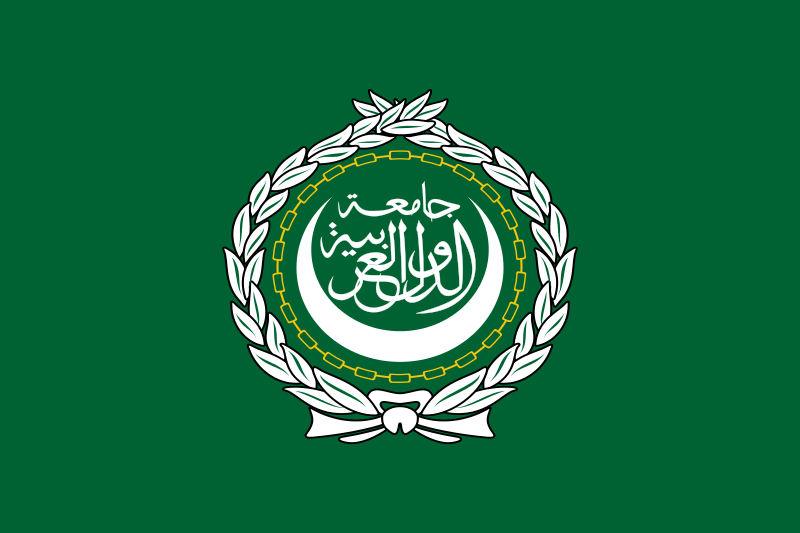
أخذت منطقة تريسينا الواقعة على ساحل صقلية في إقليم بلدية كاستيلفيترانو اسمها من طحالب بحرية حمراء معينة كان البحر غنياً جداً بها. وقد خلقت الظواهر الجوية المؤثرة على الرمال نظاماً غريباً من الكثبان الرملية على مر الزمن. وقد أبعدت طبيعة المنطقة الإنسان عنها خلال عصور ما قبل التاريخ وعصور ما قبل التاريخ. ولم تلاحظ أولى ظواهر الاستيطان البشري للمنطقة حتى بداية “البرونز القديم” (2000 – 1800 قبل الميلاد). في الواقع، في هذه الفترة، استقر مجتمع من السكان الأصليين في هذه الفترة على تمويج صغير من “تيمبون الأسود”. وتظهر الأدلة الدامغة على وجود مثل هذه الظاهرة في ستينيات القرن العشرين، عندما اعترضت مجموعة من السكان الأصليين بعض المقابر الكهفية الاصطناعية الغنية جداً ودمرتها. قام بدراسة المواد الدكتور ماركوني بوفيو الذي نجح في تأريخ المجمع بأكمله. بعد ذلك، يبدو أن عملية الأنثروبولوجيا قد توقفت بعد ذلك؛ لا يوجد دليل يذكر على وجود الإنسان حتى القرن السابع قبل الميلاد، وبالتالي، حتى ولادة سيلينونتيحوالي عام 650 قبل الميلاد، أسس مستعمرون من ميغارا إبليا بقيادة الإيكولوجي باميلو، السيلينونتيين الدوريين على سلسلة من التلال على الجانب الأيسر من موديون (سيلينو القديمة): بنى السيلينونتينيون على الجانب الأيمن من موديون (عملياً في بداية منطقة تريسينا) سلسلة من المقدسات، المعروفة الآن باسم ملاذ مالفوروس، في نفس الموقع، كما يدعي بعض العلماء، حيث كان هناك ملاذ مقدس عموم الهيلينيين مخصص للآلهة الكاثونية. هذه الإنشاءات هي الوحيدة التي بناها السيلينونتينيون في تريسينا. ومع ذلك، فقد اختاروا هذه المنطقة لإقامة أكبر مقابرهم منذ القرن السادس قبل الميلاد فصاعداً. وبمجرد تدمير سيلينونتي وتوقف المواكب الجنائزية، لم يعد هناك المزيد من التقارير عن السكن البشري في منطقة تريسينا. ومن المؤكد أن وجود المقبرة ساهم في ظهور الخرافات في العصور الوسطى. وابتداءً من القرن السادس عشر، أدى الخوف من الغارات البربرية إلى زيادة الخوف من الغارات البربرية على هذه المناطق. ولمواجهة الغارات في نهاية القرن السادس عشر، كلف نائب الملك في صقلية المهندس كاميلو كاميلياني بتصميم نظام ساحلي من أبراج المراقبة. تم بناء ثلاثة منها في إقليم كاستيلفيترانو

特里西纳(Triscina)位于西西里岛海岸线上的卡斯特尔维特拉诺市境内,其名称源于当地海域盛产的一种特殊红色海藻。随着时间的推移,大气现象作用于沙地,形成了奇特的沙丘系统。在史前和史前时代,该地区的自然环境使人类无法进入。直到 “旧青铜时代 “开始(公元前 2000 年至公元前 1800 年),该地区才首次出现了人类化现象。事实上,在这一时期,有一个土著社区在 “黑蒂姆波内 “的小瓦楞上定居下来。20 世纪 60 年代,一群人截获并毁坏了一些非常丰富的人工洞穴墓葬,这就是这种早期存在的无可辩驳的证据。马可尼-博维奥博士对这些材料进行了研究,并成功地确定了整个建筑群的年代。此后,人类化进程似乎停止了;直到公元前 7 世纪,也就是塞利南特诞生之前,几乎没有人类存在的证据. 公元前 650 年左右,来自梅加拉-伊布里亚的殖民者在生态学家帕米罗的带领下,在莫迪翁河(古塞利诺河)左侧的一系列山丘上建立了多立克风格的塞利南特(Selinunte): 塞利南特人在莫迪翁河右岸(实际上是在特里斯西纳地区的起点)建造了一系列圣殿,现在被称为马尔福罗斯圣殿,正如一些学者所说,在同一地点曾有一个泛希腊圣殿,专门供奉神灵。这些建筑是塞利南丁人在特里斯西纳建造的唯一建筑。不过,从公元前 6 世纪起,他们就选择在这里建造最大的墓地。一旦塞利农特被摧毁,葬礼活动停止,就再也没有关于特里西纳地区有人居住的报道了。当然,墓地的存在促使了中世纪迷信的出现。从 16 世纪开始,由于害怕野蛮人的袭击,这些地区的人口更加稀少。为了应对 16 世纪末的袭击,西西里总督委托工程师卡米洛-卡米利亚尼设计了一套海岸瞭望塔系统。在卡斯特尔维特拉诺地区修建了其中三座。
